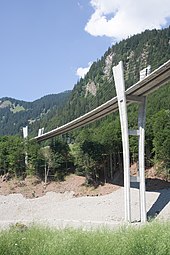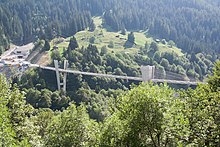Klosters bypass
The Klosters bypass is a sub-project of the extension of the national road 28 along the main road 28 in the Prättigau ( canton of Graubünden ). West closes the Klosters bypass the bypass Saas , which bypass Küblis followed in 2016. To the east is the continuation of the direction of Davos or the RhB -Autoverladebahnhof Selfranga the Vereina - rail tunnel. The purpose of the bypass routes in Prättigau is the places along the main road from the pesky Highway, specially in the high season in the winter to relieve prevails. The year-round connection from the Bündner Unterland to the Engadine also plays an important role . Since the opening of the Vereina the road is through the valley of the Landquart additional load. Before the opening of the bypass road, there was also through traffic into the Engadin, but via the Flüelapass near Davos, which was very difficult to drive safely in winter.
Connection between Klosters-Dorf
The Klosters bypass begins shortly after the Mezzaselva roundabout , where Serneuserstrasse - which opens up Serneus Dorf and Serneus Bad - branches off from the main road. The half-way connection between Klosters and Dorf follows. The new ring road extends straight and crosses the underpass Büel the turn lane to convent and the railway line of the Rhätischen web .
Sunniberg Bridge
| Sunniberg Bridge | |
|---|---|
| Surname | Sunniberg Bridge |
| location | Landquart valley between Klosters and Serneus |
| Street | Main road 28 between Mezzaselva and Selfranga |
| structural engineer | Christian Menn, Werner Brändli |
| construction | Cable- stayed bridge ( extradosed bridge ) |
| pier | 4 pieces |
| Spans | 59.00 m ↔ 128.00 m ↔ 140.00 m ↔ 134.00 m ↔ 65.00 m |
| Superstructure width | 12.38 m |
| Bridge length | 526.00 m |
| Road over ground | 62.15 m (corresponds to height above Landquart) |
| Maximum height | 77.17 m (corresponds to the height of pillar 2) |
| Maximum width | 17.25 m (corresponds to the upper width of pillar 2) |
| Deep foundation | 19.00 m (corresponds to deep foundations for pillar 2) |
| traffic | 2 lanes for motor vehicles |
| start of building | Spring 1996 |
| completion | Fall 1998 |
| opening | December 9, 2005 at 2:30 p.m. |
| building-costs | 24.8 million Swiss francs |
The Sunniberg Bridge begins behind the half-way connection to Klosters Dorf bei Büel and ends at the western portal of the Gotschnatunnel, at the so-called Drostobel. In between, it spans the valley of the Landquart on a stretch of 526 meters in a right-hand bend. For this reason, the bridge is slightly inclined towards the village of Serneus, which is located downstream. The cable-stayed bridge , which is made of reinforced and prestressed concrete , is held by steel cables that are stretched over the four pylons. The highest point of the bridge is reached at the level of the second pylon (seen from Büel), because here the roadway is around 62 meters above the Landquart, which flows along the valley floor not far from the bridge pillar . Each of the four pillars has a foundation that is about 16 meters deep. The slab was of a pillar, starting in both directions in cantilever made technique simultaneously towards the center line. The suspension ropes run in the shape of a harp from the anchorages in the deck to the pillar ends protruding above the deck. The bridge runs in a slight incline towards the end of the Drosstobel bridge. It has a circular radius of 503 meters in plan. This enables low-pressure deformation as a result of temperature and concrete creep as well as dispensing with expansion joints and bridge bearings . The two lanes - the one going uphill towards Davos or Engadin , the one going downhill towards Küblis and Landquart - are each 3.50 meters wide and therefore also suitable for heavy goods traffic to the RhB car loading station in Vereina .
Construction began in spring 1996. After completion, the bridge initially served as a construction site access to the Drosstobel portal of the Gotschnatunnel until the Klosters bypass was opened.
The bridge became a new landmark for the municipality of Klosters-Serneus. In 2001, even before its opening, the building, designed by was a civil engineer Christian Menn in collaboration with Dialma Jakob Bänziger and his engineering office, because of the unique designs with the prestigious international " Outstanding Structure Award " of the International Association for Bridge and Structural Engineering ( IABSE) , a sticker on the lane mark reminds of this.
The costs for the Sunniberg Bridge amounted to around 30 million Swiss francs .
On December 9, 2005, the Klosters bypass with the Sunniberg Bridge and the Gotschna Tunnel was opened to traffic. Prince Charles attended the opening as a guest of honor. He regularly spends his skiing holidays in Klosters.
Gotschna tunnel
| Gotschna tunnel | |
|---|---|
| Surname | Gotschna tunnel |
| location | under Gotschnagrat |
| Street | Main road 28 between Mezzaselva and Selfranga |
| construction manager | Pius Collenberg |
| construction | Tunnel using the blasting method |
| Tubes | 1 tunnel / 1 emergency tunnel |
| pitch | 4% towards the end of the tunnel Selfranga |
| length | 4207.00 m (driving tube) / 4195.00 m (emergency tunnel) |
| Maximum height | 5.07 m (central strip ceiling lighting) |
| Maximum width | 9.83 m |
| Lane width | 7.00 m |
| traffic | 2 lanes for motor vehicles |
| start of building | Spring 1997 |
| Breakthrough | December 10, 2001 |
| opening | December 9, 2005 at 2:30 p.m. |
| building-costs | 192.3 million Swiss francs |
After a short carriageway passage, you drive through the western Drosstobel tunnel portal into the 4200 meter long Gotschna tunnel, which crosses under the Gotschnagrat. First the road runs in a slight left curve, then a long, straight section follows. From here on, the emergency tunnel runs parallel to the roadway at a distance of 30 meters from the main tunnel on the mountain side. Every 300 meters there is an entrance through which you can change from the road tunnel to the emergency tunnel. Opposite the emergency exits there is an emergency call niche every 150 meters on the side facing the Klosters. Supply and exhaust air are directed through the ceiling. The Gotschna tunnel is supplied with fresh air from both ends of the tunnel. Light signals every 150 meters provide information about the condition of the tunnel, the roadway or the traffic situation. In addition, there are also CO 2 measuring devices every 250 meters in the tunnel, and post hydrants every 140 meters . As on the Sunniberg Bridge, the roadway is also two-lane, with each lane also being 3.50 meters wide.
The Gotschna tunnel was driven by blasting from both sides . The point where the breakthrough took place on December 10, 2001 is at tunnel kilometer 3.370 from the west portal . Not far from this point another left bend begins, but it is narrower than the one near the Drosstobel. At the end of the curve is the Selfranga east portal.
Construction of the safety tunnel began after the main tunnel was completed in October 2003, as it was only included in the planning at a later date. In contrast to the main gallery, a tunnel boring machine was used here. It milled from Drostobel uphill towards Selfranga. The breakthrough came on March 30, 2004. During the construction of the safety gallery, the interior of the road tunnel was completed.
The Gotschna road tunnel was completed in 8 years of construction, with 4 years being allocated to the excavation and a further 4 years to the interior work and the electrical equipment. It cost around 211 million Swiss francs .
Connection between Klosters-Selfranga
The east portal of the Gotschnatunnel comes to light again not far from the site of the Selfranga loading station . The main road 28 runs first in a slight left bend, then over a short road bridge and in another, but steep left bend towards Davos. From the main road, the access road to the waiting room for the car loading station branches off to the left, the road towards Klosters branches off to the right.
See also
Web links
Individual evidence
- ↑ Dialma Jakob Bänziger : The fascination of bridge building - balance between design and economy . In: Franz Betschon et al. (Ed.): Engineers build Switzerland - the history of technology at first hand, pp. 207–218, Verlag Neue Zürcher Zeitung, Zurich 2013, ISBN 978-3-03823-791-4
- ↑ a b Klosters bypass opened (PDF; 1.9 MB) Graubünden Civil Engineering Office Info, number 67, December 2005 at www.autobahnen.ch
Coordinates: 46 ° 53 '14.3 " N , 9 ° 51' 15.7" E ; CH1903: 784 089 / 195,744



